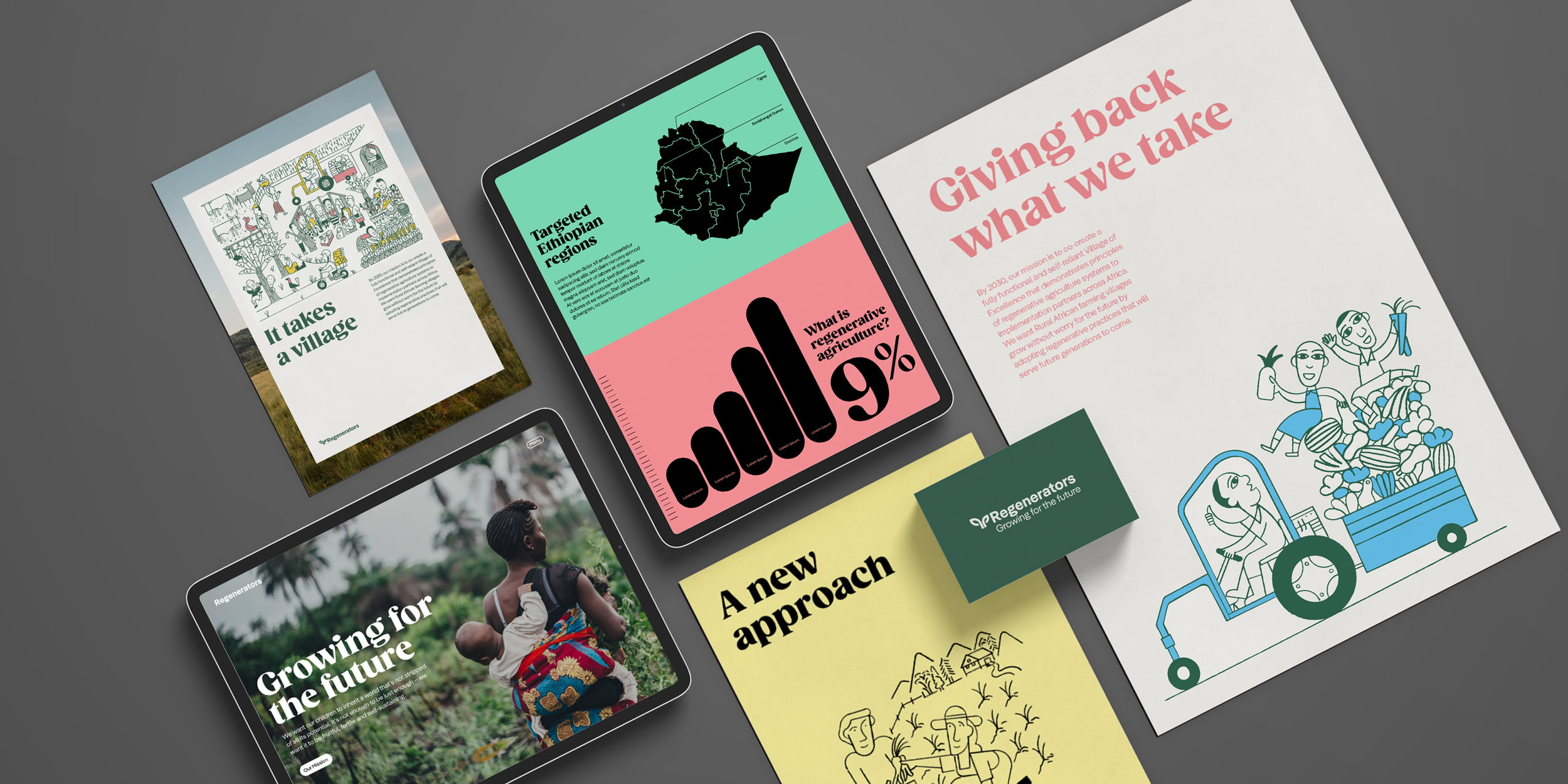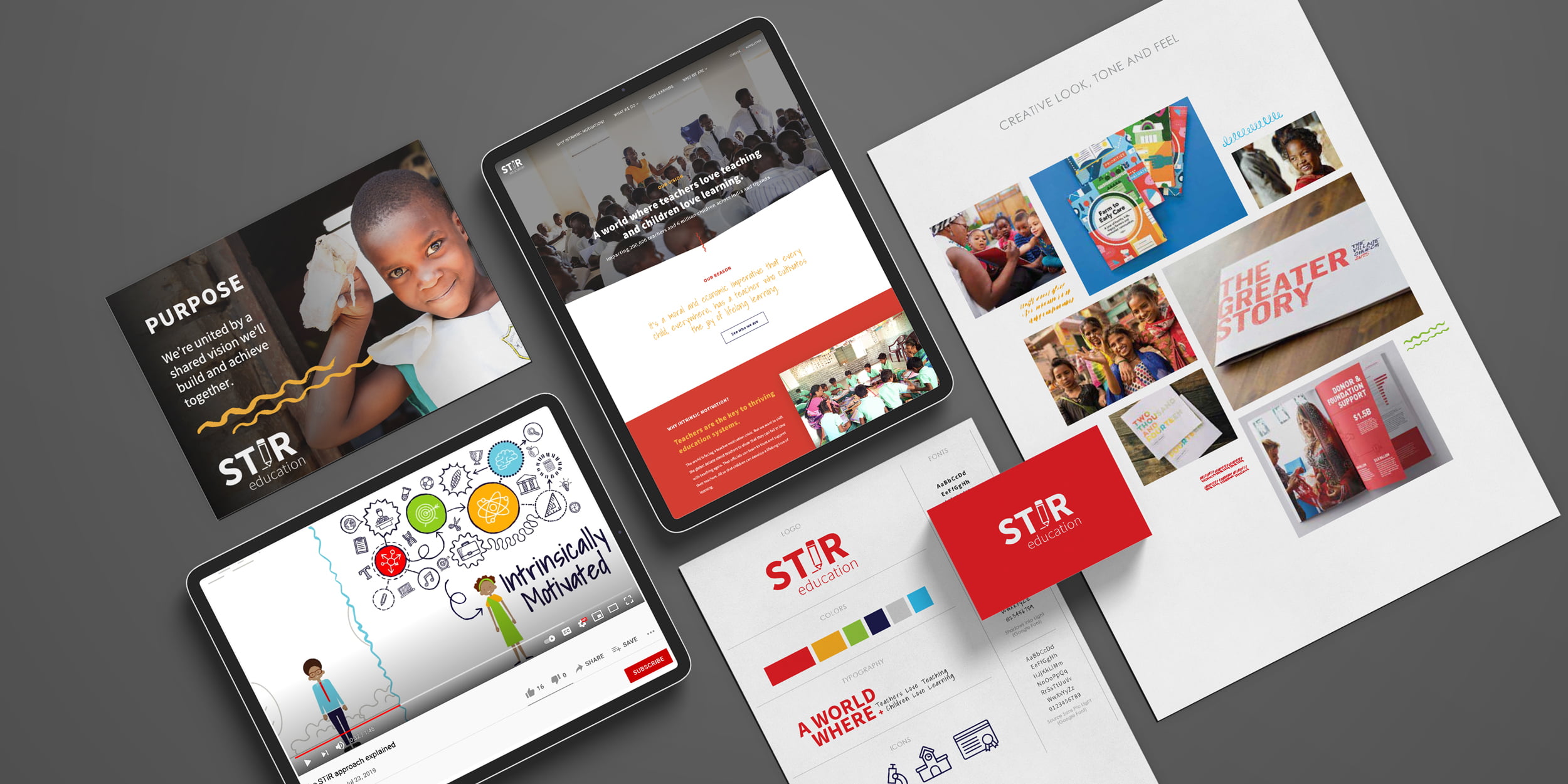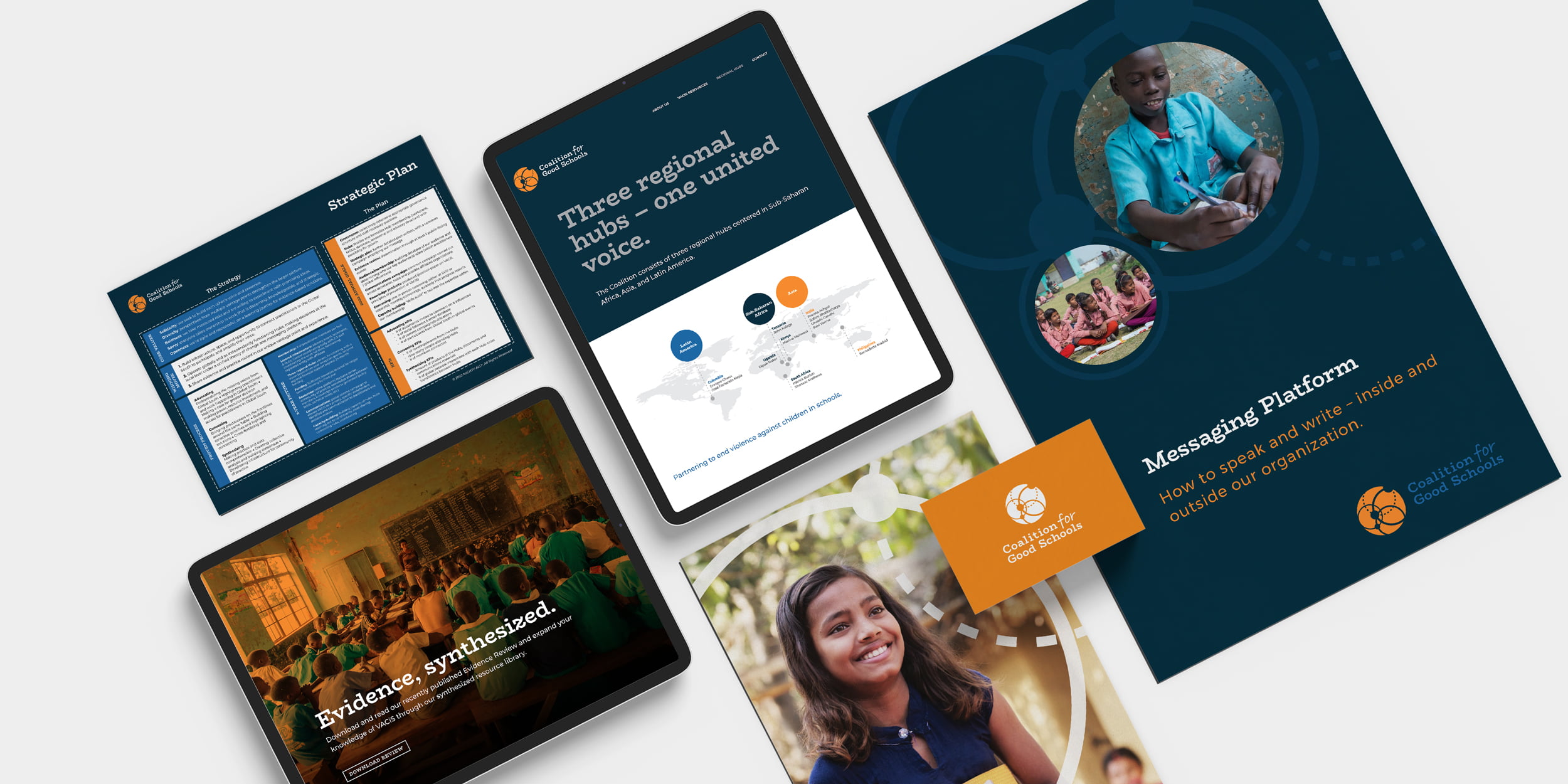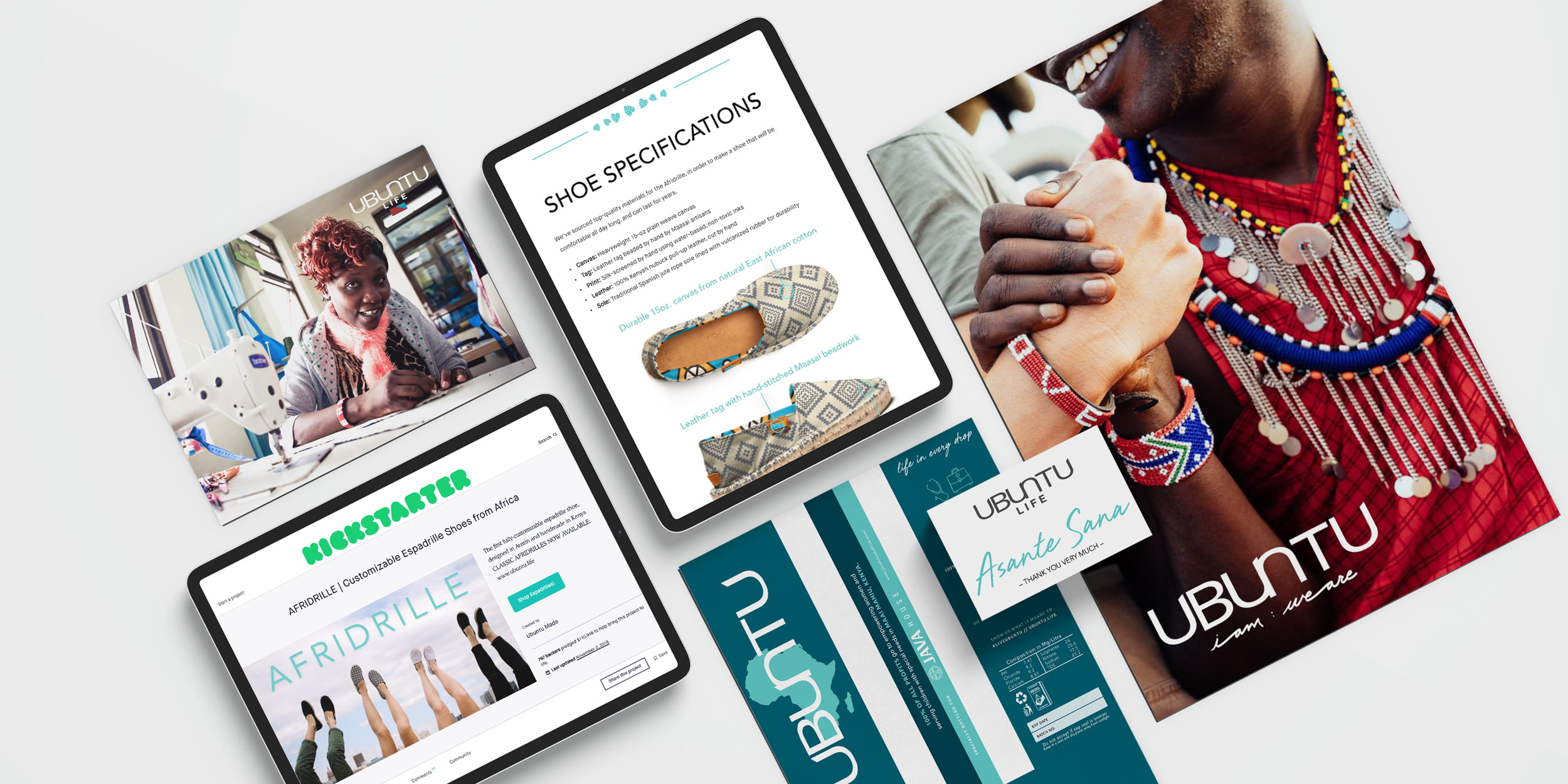Marketing communications: be findable.
Messaging and storytelling, visual identity, website strategy, channels, corporate partnerships and CSR — to maximize funding

KATHLEEN SOUDER
Hard work, intelligent products and programs, and extraordinary impact happen daily in the development world. Yet much of it goes unseen and unheard.
You don’t have to amplify your brand to achieve social change. But it’s almost impossible to scale without it. The truth is, only one in 1,000 nonprofits will ever grow beyond a small business. And of those that do scale, most are great at one thing: marketing communications.
What would climate change advocacy look like without Greta Thunberg’s appearances on late-night TV? Racial justice without the social media takeover of Black Lives Matter? Global health without Paul Farmer’s Mountains Beyond Mountains?
We applaud nonprofits that invest in their marcom as most of the sector drags behind. But we still meet organizations, leaders, funders, and donors who view marcom as a distraction from the work. Not as a core element of the work itself.
The practice of marketing communications can be overwhelming. There are no standard frameworks. And myriad ways you could amplify your brand. You have to focus somewhere. But where?
Here’s a simple guide to marketing communications. What it is, why it matters, and how to do it well — along with some final advice and tips.
A reminder: the Fundable/Findable FrameworkTM
Every nonprofit needs tight messaging, strong storytelling, sharp visuals, and cohesive communications to attract and retain donors.
But bold brands are built from the inside out. Before you can be findable externally, you must be fundable internally. That’s why your theory of change and strategic plan must come before your positioning strategy and marketing communications.
We guide early- and growth-stage nonprofits through this process using our Fundable/Findable Framework.TM
What it is: some definitions.
Marketing communications is a broad term for a broad category. It can encapsulate several different strategies and tactics. But at the highest level, marcom is the art and science of saying the right things to the right people in the right places at the right time to drive the right results.
A more literal definition? Marcom is the use of different channels and tools in combination to communicate a message to a desired market. It’s all the ways by which a social venture can educate and urge audiences — directly or indirectly — about its products and programs.
Marcom includes branding, storytelling, mass-market advertising, direct marketing, PR, digital media, promotion, sponsorships, events, etc. And it’s helpful to think of marcom in three buckets: paid, owned, and earned.
Paid media is what you have to spend money on, such as Facebook ads or billboards. Owned media is everything you control directly, like your blog posts and email database. Earned media is primarily out of your control but free, such as word of mouth or publicity mentions.
“Marcom is the art and science of saying the right things to the right people in the right places at the right time to drive the right results.”
MIGHTY ALLY
Why it matters: income & impact.
The power of marcom has been proven — over and over again — in the private sector. There are many proof points nonprofits can learn from. Because at the end of the day, social sector orgs are businesses too.
Intangible assets like brands make up 70% of the global economy. A brand accounts for 1/3 of shareholder value, according to JP Morgan. Forbes found that communicating consistently across platforms increases revenue by 23%. Aberdeen says companies with strong marcom achieve 20% annual growth.
And on and on.
So it should be obvious: improving your brand communications significantly impacts the bottom line. From increased donor conversions to landing more foundation grants and impact investment to driving more sales.
But marketing communications isn’t just about driving income. You’ve heard Mighty Ally beat the drum that a strong brand and good marcom can generate impact too. Whether it’s the less tangible value of reaching beneficiaries, influencing government partners, or recruiting staff and volunteers.
The Communications Network unveiled a research project called Communication Matters, shared in this excellent SSIR series. They found that social ventures that excel at communications are stronger, smarter, and vastly more effective. Sean Gibbons goes on to say that communications is no longer an appendage to the work, but an integral part. In other words, it is the work. “Strategic communications can revolutionize your organization and exponentially expand your impact,” he says.
“Halting climate change. Eradicating disease. Lifting up the arts. Ending poverty. At their core, foundations and nonprofits are in the business of developing and advancing big, bold ideas. If you want your ideas to take hold and win, you need to communicate and communicate well. It’s not an option anymore — it’s a necessity.”
SEAN GIBBONS, THE COMMUNICATIONS NETWORK
How to create your marketing communications: the Mighty Ally process.
As we said above, marketing communications isn’t one single thing. It’s a collection of work. And at Mighty Ally, our marcom work is the meatiest of anything we do. It includes the following five elements: messaging and storytelling, visual identity, website strategy, channels, and corporate partnerships. We’ll cover these elements below. Then we also produce a few other vital brand touchpoints like pitch decks, covered separately in this post.
Messaging & storytelling
Even leaders intimately familiar with every organizational detail can feel daunted when speaking or writing about their organization. We’ve all been there. You sit down to write an intro email, grant proposal, or social post and feel stuck. You paste paragraphs from old documents or go to your website’s about page to copy details.
A visual identity has brand guidelines specifying colors, fonts, and logo standards. Your messaging and storytelling need such a guide too. One with accurate, up-to-date content your entire team can reference and use.
The messaging and storytelling platform holds the foundational, strategic building blocks that direct how you write and talk about your social venture. It’s a content starter bank. Tools, terms, and copy blocks to pull from.
The platform helps everyone in the company deliver consistent messages across all types of content. Everyone who works on your organization’s behalf — from the staff to your board — will be speaking from the same ‘script.’
Consider this platform a living document. As your organization grows and evolves, your messaging and storytelling platform will too. Its value lies in being an up-to-date reference tool. So set reminders to re-read and tweak.
For more about the seven tools within a good platform, dig into our detailed blog post: The beginner’s guide to messaging & storytelling.
Messaging & storytelling tools

Our brand work with client Regenerators is beautiful, thanks to agency ally Saol. But one reason the visuals are so compelling is the messaging within. Bold headlines, crisp copy, intriguing narrative. Strong messaging combined with eye-catching visuals — the next topic — is magic.
Visual identity
Your brand isn’t your logo, just as the clothes don’t make the person. Like people, brand is deeper than how it’s represented on a page. But we all make specific choices on how to dress for a job interview or first date. Because appearance can and does matter.
A well-crafted visual identity communicates a lot immediately. And since the human brain processes images 60,000 times faster than text, even a glance at a visual communicates much.
There’s a mantra in the design world: “form equals function.” This means an excellent visual identity isn’t just a set of marks pleasing to the eye. It should be built on intentional choices and informed by your theory of change and positioning strategy. Every visual identity element should have a purpose. And all must work together to communicate something — or many things.
Creating a brand identity gets you to the starting line. Unfortunately, using it effectively is where many stumble. Logo files are buried in an unknown folder. Employees never download fonts. The colors used are close but not quite. If you put time and money into a new or refreshed brand, don’t let it collapse months after your designer hands off the files. Practice organizational discipline to extract the total value of your investment.
At first glance, you might simply describe the refreshed STiR Education brand below as pleasing, happy, and bright. But a deeper dive into their visual identity uncovers the intentionality behind every visual element.
Visual identity elements

The STiR Education visual identity reflects principal elements of their theory of change and positioning strategy — making them memorable and attractive to their various worldwide audiences. The color palette appeals in all the countries where they work. Typography balances a clean, professional typeface with a lively, handwritten one. The photography style reflects STiR’s impact and dynamism. And the brand is accented by a library of icons — drawn with a loose, organic hand.
Website strategy
A website is the most critical communications channel for any nonprofit. But it’s commonly a disastrous afterthought. Web strategy can feel too complicated. Good design and content seem expensive. Or leaders say there’s no time or team.
Even if only once, almost every priority audience will visit your site — from individual donors to government partners to potential staff. We could even argue a website is the ultimate expression of your brand strategy.
So why are nonprofit websites notoriously bad? Thanks to out-of-the-box solutions, building a site has become remarkably cheap from a design and technology standpoint. You can find talented freelancers anywhere and activate them quickly. It seems the strategic connective tissue is what’s really missing.
A website strategy is simply a plan of action that directs your website’s content, layout, and funnel. It considers your business objectives, then outlines ways your site can align with those plans to help reach your goals. It’s a basic document that rallies the brainstorming, ensures leaders are on the same page with decisions, and allows a seamless handoff to website developers. It serves as a reference point throughout the website design and coding to come.
Here’s our website strategy formula for growth-stage social ventures. Remember 1-3-5-7-9 for the elements that matter most: one call-to-action, three audience goals, five sitemap pages, seven homepage sections, and a $9,000 maximum budget.
Read more about our website strategy formula in our blog post: Why your website strategy is missing the mark.
1-3-5-7-9 website strategy formula

Coalition for Good Schools was a new organization when it became a client — a collection of entities from seven countries focused on violence against children in schools. As a new brand, its website strategy had to match the organization’s maturity. Clean and sophisticated in appearance but not overly robust in function.
Fundraising & sales channels
How do you get your brand’s message out to the world? In our hyper-connected society, you have myriad routes — channels — by which you can transport your brand’s messages and ideas to the people you want to reach. But before you can choose your channels, you have to know your options. And there are many!
To further complicate matters, you can decide to use each channel yourself or team up with a collaborator. For example, you might go it alone, investing in messages your org transmits directly. Or you could rely on partners to help spread the word. Like community leaders, influencers, other nonprofits, funders, or brands who mention or feature you on their channels.
“We need to start posting on Instagram, right?”
“I know we should be sending out more emails each month.”
“That organization always has great brochures, and we have none!”
We hear statements like these all the time. Clients come to us feeling inundated by all the channels available to them — unsure of where and how to start. Here’s some good news: you don’t have to do it all.
For channel selection, we like the rule of two. For each quarter, campaign, or even your overall marketing effort — pick a primary channel. Then choose a secondary channel to augment the first.
Yes, that’s it. Growth-stage nonprofits have small marcom teams and small marcom budgets. You have to focus.
Perhaps you know email appeals drive individual donations. So create an email campaign strategy and supplement it with social media posts. Focused on advocacy or advancing the conversation in your sector? Make a hit list of conference speaking opportunities. Then commit to sharing that presentation content during quarterly webinars. You get the point.
And by looking at the data, you’ll know how and where to adjust next time.
With channels in place, let’s move into how corporate partnerships can help turn up the volume.
Example channels

In our 24-month engagement with Justice Defenders, we experimented with a multichannel strategy to help decide where to focus in the future. The marcom mix included a TV appearance on 60 Minutes, speaking gigs, free Google Ads, email marketing, content development, online donor clubs, and a virtual Christmas Carol Service during COVID. Of course, no growth-stage social venture can keep up this level of marcom forever, but testing the waters can be a wise strategy.
Corporate partnerships & CSR
Nonprofits beg for money, desperate for any funding. And for-profit companies donate, pulling cash from their overflowing coffers. We’re conditioned to expect this dance. It’s ingrained in our sector, underscored by scarcity mindsets, upheld by power imbalances, and cemented by inequitable relationships with funders.
But it doesn’t have to be this way. The relationships brokered between for-impact and for-profit organizations can be a powerful, mutually beneficial tool.
Like any other marcom activity, corporate partnerships don’t happen overnight. But they can and should be considered part of your long-term success strategy — generating tangible and intangible returns.
Shared value — coined in 2011 by Michael E. Porter and Mark Kramer — can structure the relationship between for-profit and nonprofit. Instead of creating net-new initiatives for delivering on social good, companies can work alongside existing organizations. Trading value for value and sharing in the positive outcomes.
Speaking confidently about shared value is important when approaching brands for possible partnerships. We use four P’s as useful buckets to organize details of a co-amplification partnership.
Here are some Mighty Ally client examples:
People — Reach a Hand Uganda is a sexual and reproductive health and rights (SRHR) nonprofit in Uganda. Lucky Bloke is an international condom retailer with vast expertise around safe sex practices. Instead of just donating money and product (which they did), Lucky Bloke spent time with the RAHU team — sharing their knowledge and training them on the latest trends in SRHR.
Platform — Waves For Water has partnered with global travel brand Tumi for years. Besides funding, Tumi helps capture images, stories, and videos. Then broadcasts this content across their digital and social channels. Tumi’s brand marketing team promotes core attributes of adventure and exploration, while Waves For Water reaches vast new audiences.
Philanthropy — For large corporations, philanthropic money will flow through their foundation. And it’s a great place to start (take that cash!). But tapping into their people, platform, and product can be just as valuable — strengthening your mutually beneficial relationship. Like Lwala’s multi-pronged partnership with the corporate side of Tivity Health, its chosen nonprofit partner Health eVillages, and even the CEO’s personal fund, the Tramuto Foundation.
Product — Kenyan nonprofit Ubuntu Life has brokered a mutually beneficial partnership with African restaurant chain Java House. Through Ubuntu Life’s social enterprise arm, they sell co-labeled bottled spring water to the cafés. This delivers earned revenue and brand recognition to the nonprofit, while Java House can access a good product at a fair price.
Partnership elements

Nonprofit client Ubuntu Life is a shining star example of partnerships done well to amplify a brand. Their corporate partners include Java House, Whole Foods, Goodio Chocolate, Zazzle, YKK, and the activation we brokered with Austin City Limits Music Festival.
Final advice and tips.
Pulling it all together.
You’re armed with a memorable visual identity. You’re on message, saying the right thing consistently. The website is spot-on in both form and function. You’ve prioritized marcom channels, connecting you to your target audiences. And a few lucrative corporate partnerships are shaping up in the background.
It’s time to put these pieces to work, guided by a plan.
There’s no single right way to draft a marcom plan. We’ve seen everything from multi-tabbed Google sheets to bullets scrawled on whiteboards.
But we’ve developed a marcom plan template we think strikes the right balance between comprehensive and streamlined. Your team is likely stretched thin, doing a lot with a little. No need to go overboard here.
-
Set a goal. What are you trying to accomplish? One sentence, keep it simple and concrete. You might decide to set a monthly goal, quarterly goal, or a goal that’s specific to a discrete campaign.
-
Define your strategies. With directional pillars in place, figure out how you’ll engage. Note that a strategy is broader than a channel but starts to focus on what you’ll be doing.
-
Pick your channels. Until you have a fully functional marketing machine, streamline your channels. Choose a primary one as your main focus. And a secondary one to support.
-
Pinpoint objectives. Goals set high-level outcomes. Whereas objectives are granular and highly measurable. Use benchmark data from past efforts if you have it. Or start with general targets and get precise as you go.
-
Get tactical with deliverables, budgets, and to-dos. A good marketing plan is detailed enough to garner consensus and sign-off. What are the deliverables needed to execute this strategy? A mailer? A cleaned-up list of lapsed donors? A landing page for a downloadable white paper?
-
What’s your budget? Estimate hard costs for graphic design, hosting, event fees, or ad spend. And outline how much time your internal team will spend on executing against the plan. Both pieces are important. Without a sense of your investment, you won’t know if your results were worth it.
Working with creative teams.
Many growth-stage nonprofits bootstrap the basics of marcom. Except for visual identity design. This work is best left to creative experts versed in design mechanics and translating strategy into visuals.
Depending on your needs and budget, you could engage a creative agency. Or you may have access to a volunteer willing to work pro (or low) bono. Services like Catchafire and Taproot Foundation could also be an avenue to connect with professionals willing to donate their expertise for your cause.
Finding your design partner is just the first step. Collaborating with them and shepherding a process to completion is more than half the battle. So put these best practices to work:
-
Dedicate time to bring your designer up to speed on your founding story, business model, and culture. With Zoom now ubiquitous, connecting a creative professional with your team on the ground is doable and will help them care about your important work as much as you do!
-
Again, nail your theory of change and positioning strategy first. Walk the designer through both — helping them frame their creative vision within a solid organizational strategy. Once you communicate the big picture, share specific needs through a one-page creative brief.
-
Create a RACI matrix upfront to drive internal clarity on who gets to weigh in and when — senior leadership and board members included. Nothing derails a creative project more than someone jumping in at the eleventh hour.
Being data driven.
Good marketing starts and ends with data. So before you pick your channels, take the time to do some qualitative and quantitative research. You don’t have to be a statistician or researcher to glean insights.
-
Competitor analysis. Look at what similar orgs are doing. Examine their online presence to learn how, where, and when they’re communicating. Where are they successful? Or falling short? You may align your channel strategy with theirs or make it distinctly different.
-
Historical data analysis. Poke around Google Analytics. How big is your website audience? Where do they live? How long do they spend on your site and on which pages? Most channels have built-in tools to help you assess performance. Like your email platform: how many people open, click, or unsubscribe?
-
Set goals and measure progress. If you have historical data to use as a benchmark, great. If not, use industry norms or make your best guess. What’s important is connecting your marcom efforts to data-driven outcomes. And getting the info you need to double down on certain channels or abandon others.
We’re just years away from 2030 — the date our sector set to achieve the Sustainable Development Goals. And we’re behind. Despite the tireless work of millions of people worldwide to improve our collective quality of life, we have a long way to go.
We can’t claim that committing to marcom will let us meet the SDGs. But we do know that without a commitment to amplifying the brands of those making an impact, we’ll never get there.
So get to it. Tell your story. Share your expertise. Connect with supporters. Raise awareness. Do this with confidence, knowing the effort isn’t a distraction from or an addendum to your work. It’s part of the work itself.
Amplify your brand. Because there’s too much at stake not to.
Read more articles
Ready to get fundable and findable?
Learn how we can help maximize your funding.

